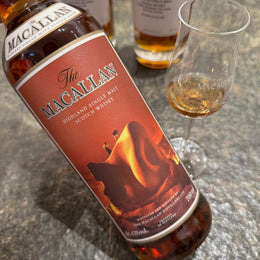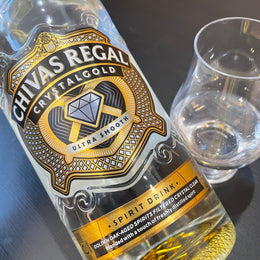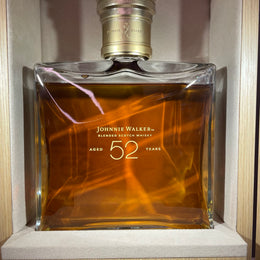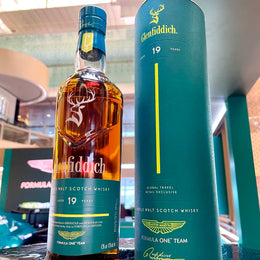
One of the most evergreen lever that any spirits maker can always count on is to make an experimental expression - whenever, wherever, it's most definitely going to work, so long as it actually is in some way, shape or form, experimental. Seriously - can it ever not draw rejuvenated interest? Are we ever over experimental stuff? Well, it certainly works on me.
And so when I was informed that a pair of Laphroaig's new Elements series L 1.0 and L 2.0 were available at the local watering hole, The Swan Song Bar (in Singapore), I had to simply toss whatever I was doing and get myself over.
The Islay giant's new Elements series was unveiled in late 2023, and as we enter mid-2024, we've already discovered two Elements so far.
Much as its name suggests, the Elements range is dedicated to showcase the innovation and creativity from the beloved distillery's distilling team. Each Elements release will thus feature some unique twist on what Laphroaig has been up to behind closed doors.

And so with that said, let's get this going!
Laphroaig Elements L 1.0, 58.6%ABV - Review
For the first Elements L 1.0, we're getting three experiments packed into one expression - the use of a cloudy wort (that's supposed to bring more tropical fruit), two new mash tuns, and the use of 100% Islay malt.
The inspiration here was to showcase the marked effects of changes to the base materials used for Laphroaig's whisky.

Tasting Notes
Colour: Gold
Aroma: Heavy on the candied fruits! There’s pink guavas, kiwis, langsat, jackfruit, custard apples, seriously coated in maltose candy and honey. It’s a mix up of fleshy tropical pink fruits and white fruits, along with some muskiness too. And while all that is going on, there’s a good clean smokiness about it, although there are also big notes of BBQ, spent charcoal with the white cinders, as well as some kombu seaweed and iodine. There’s also some herbal qualities here of medicinal roots as well as some cough syrup. But really the tropical fruits dominates the fore.
Taste: It opens up honeyed but also with a much more medicinal quality - here’s the medicinal bandages, iodine, a good heap of briny sea spray, kombu seaweed. For a split second there’s a flash of candied tropical fruits that sort of comes and goes - pineapples and guavas namely. It’s medium-bodied, really focused and intense in the delivery.
Finish: More medicinal into the finish, lots of that iodine, bitter ash, spent charcoal, burnt ends, burnt earth, dried medicinal roots, cough syrup. This is amplified by the herbaceousness with lots of dried herbs. This is underscored by some honey and bits of candied tropical fruit - pineapple comes to mind, that keeps the medicinal notes in check. Long on the finish.


My Thoughts
The fruits are definitely turned up here on the nose - almost entirely most prominent on the nose - giving us a glimpse of the very tropical fruits that have made legends of several Laphroaig’s. Here it’s coated heavily in candy and honey, which in a way tones down the brightness and makes us focus on the richness of these fleshy tropical fruits instead. That seems to be the opening act.
From here, we step into heavily peaty territory with all your classics - those medicinal and herbaceous qualities dominating, big, bold, heavy handed, and yet comes through massively in flavour without overstaying in texture. Is that what they call phenolic? It’s oily, smooth and has a good richness about it that almost seems separate to the flavours - here that feels like a good thing. It does the job of delivering the flavours perfectly without blunting it with flabbiness. It’s really coastal without being particularly smoky, the fruits staying for much shorter than we’d like.
The finish feels like an encore - it’s everything of the two acts thus far but amplified and given more intensity and austerity. With the sweetness receding somewhat, and while it continues to support the fruits and peat, it’s fading out gives us the chance to see the expression bare bones with much more detail and therefore much more clarity.
On the whole, I find this to be pretty well-made, it’s definitely different from what Laphroaig has on at the moment, definitely bringing the flavours up a notch, giving it more intensity and balance, it feels alot bolder and pronounced here. What impressed me most here is the precision and detail of the earthiness, which felt well expressed. Even as someone who isn’t big on peat, I can see the finesse here particularly with the earthiness of it, but I will emphasise that I can only wish more of the fruits made it to the palate. Nevertheless, this should be a hit with peat lovers.
My Rating: 8/10
Score/Rating Scale :
- 9-10 : Exceptional, highly memorable, 10/10 would buy if I could.
- 7-8 : Excellent, well above most in its category, worth considering buy-zone.
- 4-6 : Good, okay, alright; a few flaws, but acceptable; not bad, but not my personal preference; still worth trying, could be a buy if the price is right.
- 1-3 : Not good; really did not enjoy; wouldn't even recommend trying.
- 0 : Un-scored, might be damaged, new make, or very unusual.
Laphroaig Elements L 2.0, 59.6% ABV - Review
For Elements L 2.0, the focus will be on experimental distillation techniques - in particular, fermentation time was stretched to 115 hours (nearly 5 full days), which is said to be much longer than the industry standard of 60 - 75 hours. For reference, the fermentation time for the Elements L 1.0 expression was 55 hours.
Furthermore, a specially aerated mash tun was used, which is said to create a deep and fruit whisky.

Tasting Notes
Colour: Dark Gold
Aroma: Big notes of honey, encased in some salty sea spray, cold smoke, fresh seaweed washed up to shore, and then juicier stone fruits of ripened apricots, nectarines, plums, juices flowing, and just alittle bit of candied pineapple. This comes off sweeter, richer, more coastal and altogether more rounded. With time, some guavas and tinned fruits are emerging too. The smokiness exists but remains all the way at the back, with some mustiness of a wood cabin in a cooler climate hovering about.
Taste: This feels richer, more rounded, certainly sweeter - honey, some peaches and apricots, some tinned peaches. Closely followed by some more medicinal cough syrup, herbaceous notes here of dried mint and thyme. There’s a slight bit of leather at the back.
Finish: More medicinal here, drops of iodine, cough syrup, backed up by quite a bit of salinity and just a slight bitterness. Some cold cigarette ash too, made easier with just the slightest honey and pineapple. Shorter on the finish but also softer.


My Thoughts
This was another very different Laphroaig than what we’re currently getting from the Islay distillery - it’s alot richer and bolder with the sweetness. It’s chockfull of juicy ripened and tinned fruits - most prominent on the nose, but here it does mostly translate to the palate. On first impressions, I was pretty enamoured with the sweeter, fruitier aromas on the nose - just that absolute juiciness like freshly cut super ripe orchard fruits. The palate gave more richness, which almost concealed the medicinal qualities, which ended up requiring multiple sips to pinpoint.
But the palate did feel more generous and at the same time still had a pretty good focus and concentration. Nice punchiness, although it was alittle more mellow. The finish was where the medicinal qualities began to really come through, quite intense I should say, although it did end on a relatively short note.
Altogether pretty tasty, definitely better suited for the majority of drinkers, myself included, with really nice big juicy fruits on show here, without compromising too much on the Laphroaig experience - don’t worry you’ll get it in spades on the finish.
My Rating: 7/10
Score/Rating Scale :
- 9-10 : Exceptional, highly memorable, 10/10 would buy if I could.
- 7-8 : Excellent, well above most in its category, worth considering buy-zone.
- 4-6 : Good, okay, alright; a few flaws, but acceptable; not bad, but not my personal preference; still worth trying, could be a buy if the price is right.
- 1-3 : Not good; really did not enjoy; wouldn't even recommend trying.
- 0 : Un-scored, might be damaged, new make, or very unusual.

The Bottom Line
Two pretty different expressions from what Laphroaig currently offers - wow, two for two, this Elements series is really shaping up!
It almost feels abit difficult to compare the two in terms of quality - both are well-made, but also very different, hitting me at different spots. For a start, the L2.0 is definitely way more accommodating, lending itself a more friendly front to most drinkers, you’re not getting nearly as much of that peaty, medicinal, herbaceous and bitter qualities here - the L2.0 is alot sweeter, rounded and richer, which is just generally alot more comfortable for most palates. The L2.0 definitely goes down better for me as someone who isn’t such a fan of peat.
However, I think it’s worth pointing out that I have to concede that the L1.0 is the more impressive of the two. The L1.0 is unquestionably more complex, has a better intensity, bold in its delivery, big flavours and at the same time sports a better cadence in the tasting experience. It feels like a theatrical play where you’ve got multiple acts that lead into one another - which just makes it that much more fun and entertaining. It screams mastery at work. The L2.0 whilst more forgiving and is of course not without its merits - that sheer juiciness! - feels inoffensive, alittle too forgiving, and therefore feels not nearly as tight and chiselled, as if there are a few missed beats. That lesser precision, complexity and evolution, all makes me appreciate the L1.0 more, even if it was not quite to my preference being not a peat fan.
The winner for me is therefore the L1.0.
Kanpai!

@111hotpot







